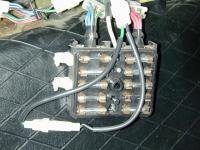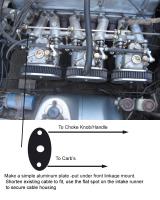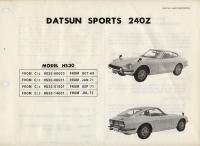Everything posted by Carl Beck
-
New BRE website!
Hi Dennis: Like many I've been looking forward to this for some time now, and I'm checking the site almost daily to see what progress has been made. Of course my favorite Section is the <a href=http://www.bre2.net/index.php?section=28 TARGET=NEW>"BAJA"</A> thanks for letting us all know... kind regards, Carl Carl Beck Clearwater, FL http://ZHome.com
-
Triple Carb vs. Holley 4BBL Carb
You should swap that S.U. out for a Weber.... Carl B.
-
Datsun-240z Vs Fairlady-z432
Hi Kats: What is the diameter of the DATSUN COMPE steering wheel? Is COMPE an abbreviation for COMPETITION? regards, Carl B.
-
Datsun-240z Vs Fairlady-z432
Hi Kats: That fuse and fuse holder are most likey for the electric fuel pump. Note same wire colors etc. See thread: Fuel Pump Wiring - Post #11 (picture below) http://www.classiczcars.com/forums/showthread.php?t=27902&highlight=Electric+Fuel+Pump+Fuse FWIW, Carl B.
-
Triple Carb vs. Holley 4BBL Carb
This was discussed at: http://www.classiczcars.com/forums/search.php?searchid=508167 but Mike said: It is a very light tint... but can be seen when side by side with the non-tinted glass. FWIW, Carl
-
IZCC Listserv closing
The URL for the "IZCC HISTORY" http://www.zhome.com/IZCC/History_IZCC.html Only the e-mail based discussion group aka "the Z Car List" .. is closing down.. The IZCC will still be at it's virtual home on the World Wide Web - "The Z Car Home Page" at http://ZHome.com Our membership data base is close to 15,000 members now - and our membership e-mail lists, will provide whatever communication with our members is needed. We will still maintain our on-line, searchable membership data - so that the Z Car Community can locate fellow Z Car Fan's in their area or state. We will still maintain our list of Local Z Car Clubs so visitors can find a Z Car Club in the physical world that is close to them. Etc. Etc. Etc. FWIW, Carl B.
-
Happy new member.
For 1970 the "Green" was #907 and Datsun called it Racing Green http://zhome.com/History/colors.html and http://zhome.com/History/ZColorGallary/index.html Looks like a very nice Z to have. FWIW, Carl B. Carl Beck clearwater, FL USA http://ZHome.com Z's..several 510 Station Wagon... love it!!
-
Choke question re: triple Webers
See: Mr. Woof's72z for his set up http://www.classiczcars.com/forums/showthread.php?t=28153 I used his picture to show another... You really shouldn't need chokes in California.. unless you go to the tops of the mountains... FWIW, Carl B.
-
East African Safari Classic Rally 2007
Hi Guus: Thanks for the great coverage - keep it coming!! Although the photographs thus far are excellent.... I'm sure hoping that someone will get some details of the Z's - engines, suspension, special prep items... kind regards, Carl Carl Beck Clearwater, FL http://ZHome.com
-
Triple Carb vs. Holley 4BBL Carb
Hi Tony D / everyone: ""included the "Sports" 240"" ... That makes it sound like there was more than one model - there wasn't. The 69 brochure covered the Datsun 240-Z as it was spec'd for the U.S. at that time. There was no lower trim level vehicle mentioned at that point, that I can find. The 1970 Showroom Sales Brochure, that outlined the standard trim, equipment etc actually raised the trim level. (while spec.'ing out the 150HP emissions version) After that brochure went to publication, Nissan included Tinted Glass and Rear Window Defroster as Standard Equipment also. (although it was listed as Optional in the 70 brochure). Emissions Policy - what can we say? The U.S. Voters got what they wanted - less pollution from the cars. Many people thought that was a good thing - and therefore the better car: but I know what you mean. Interesting to note that in the long run, those heinous US Emissions Requirements, may have actually lead to far better performing engines today. We'll never know if the manufacturers would have applied the available technology as it came along - of if they would have invested billions of dollars in the necessary R&D to develop it, without being forced to or not.... but I doubt they would have. If we are looking at the choices Nissan's conservative engineers made - it is important to note that selection of the S20 for the Z in Japan, was a Management decision, not an engineering choice. Given that the S20 was a Prince Engine - we'll never know if the engineers at Nissan would have selected it or not. Neat as the 432 was at the time, or neat a total package as it is still today - the S20 was selected to comply with Japanese government restrictions on engine displacement, while offering a great performing 2.0L engine in the JDM (even if at a significantly higher tax rate and initial price). Emissions or Displacement - government's influence drives engineering choice most of the time. Competition Rules and Regulations drive engineering choice at other times. While the triple carb'd L24 produced 175 HP - it also used a 10.5:1 compression ratio - whereas the 150 HP version was lowered to 9.0:1. So I'm not sure how much HP gain can be attributed solely to the carb's in that case. FWIW, Carl B.
-
California Zs
If they were here - there are a couple that I'd just go buy today. But - this is the one that will sell first and for the most: http://orangecounty.craigslist.org/car/472915756.html FWIW, Carl B.
-
Triple Carb vs. Holley 4BBL Carb
Down-draft vs Side Draft: Just one case of engineering "choice" for example: Interesting that Mr. Iida commented in an interview reported by Nostalgic Hero, that when his team designed the first L20 in-line six cylinder, OHC engine (with a four month design cycle), they used side draft carb's because they had less resistance to flow, than the down drafts, and thus produced more HP and Torque. (115 ps or 113.43HP) Everything in Engineering is a trade-off however. Mr. Iida also said that the reduced resistance to flow of the side draft carb.'s, combined with poor valve stem seals - - resulted in oil being sucked up the cylinder walls, and the oil rings used were not sufficient to initially seal, nor wipe the walls clean - thus high oil consumption resulted. He also tells us that the twin carb's were difficult to tune and the original L20 suffered from a high idle speed - which caused higher fuel consumption and customers complained about the noise at idle from the engine. A year after initial production, the second version of the L20 was equipped with a down draft carb. - lost some HP/Torque (now down to 105ps or 103.56HP), but equipped with new valve seals and newly designed oil rings, combined with reduced flow from the downdraft carb - the oil consumption was brought under control, and with the down-draft engine idle speed was lowered to increase fuel mileage and reduce noise in the car at idle. {on later engine designs, in addition to better rings and seals - Positive Crankcase Ventilation reduced the tendency to suck oil past the rings and valve stems into the cylinders - when pressure went negative in the cylinder, relative to the crankcase - on the intake stroke. Engines designed later had to have PVC to be exported to the US starting in 67 AIR...cjb} FWIW, Carl B.
-
1972 240 carb to fuel injection conversion?
Hi Jared No problem - I understand completely.... the problem with having only written comments is we miss tone and facial expressions... Just like Stephen's "vaunted" as a good thing... My house and garage are filled with "historic junk"... Speaking of going off topic - heck I still have a Mac SE running with MacDraw in my office... -VBG- All the wonderful leading edge stuff for their time... FWIW, Carl B. with disks from a CDC 300MB Hard Drives - with Removable Disk Packs..circa 1980...at $49,500.00. Built with licensed technology from Honeywell - we only had to pay $25,000.00 for the drives direct from CDC!! Only the old guys recognize them today....
-
Clear glass vs tinted glass
HS30 00501 would be the first 1971 RHD Datsun 240-Z according to the factory. Should have the fresh air exhaust vents in the quarter panels. I think Kats or Chris posted this before...image below. FWIW, Carl B.
-
John Williams, Sunbelt Preformance & Classic Motorsports Mag.
Hi Steven: It wasn't the "project" that caught my attention - it was more specifically Sunbelt Performance and John Williams. Some of us know John, and were just talking about his driving etc at the recent ARRC... Sunbelt Performance and John did the rebuild and restoration on my BRE Z's engine... Sorry to say I did miss your earlier thread about the exhaust system... I'm sure I would have followed it had I seen it. I owned/operated a muffler shop for a couple years... built a lot of exhaust systems for Z's in the mid-70's... Glad to see that MSA seems to have improved theirs... FWIW, Carl
-
John Williams, Sunbelt Preformance & Classic Motorsports Mag.
....and the reason you didn't share it with the rest of us at that time....is??.....
-
1972 240 carb to fuel injection conversion?
Hi Guys: Just so we aren't taking across one another - nor giving conflicting advice to Shoottathril200 - - my response was really aimed at the original Post - wherein Shoottathril200 ask about "adapting" a 280ZX F.I. system to his 240-Z. Not really talking specifically about racing, nor increased performance in his case - - more about being able to properly tune out a F. I. System for his L24 and using modern aftermarket parts that are easily available and relatively inexpensive etc. I wouldn't swap out the OEM system on a stock 280Z/280ZX... nor recommend it. FWIW, Carl B.
-
New owner, Socal!
Hi Stephen: I worked for DATSUN in 74/75. The 260Z's built on the 280Z Bodies had to be sold and titled as 1974 or 74 1/2 Model Year Vehicles here in the U.S. The L26 could not meet the U.S. Emissions Standards in effect for 1975. If that 260Z was titled as a 75, it was a title error or mistake of some kind. It would seem that it would make it very difficult for it to pass the CARB standards for a 75 model year in California - at least in years prior (if it was in California when still requiring vehicle inspections for emissions etc). FWIW, Carl B.
-
John Williams, Sunbelt Preformance & Classic Motorsports Mag.
See: http://www.classicmotorsports.net/news.php?cat=14 FWIW, Carl B.
-
1972 240 carb to fuel injection conversion?
Hi Jared Well my conclusion may have seemed a little too insensitive - but I hope the rest of it was more a consideration of the technology, than just my opinion. Lets face it, can you plug your P.C. into your Jetronic System and reprogram the fuel maps, adjust the volumes and air/fuel ratios to account for different engine displacements, head flow rates, new cam profiles, or different spark timing curves? Don't get me entirely wrong - I love the 280Z's and yes they run just fine with the system the factory equipped them with 33 years ago, but the system wasn't programmed for the best performance possible. I agree that for it's time, the system was pretty effective and mostly easy to work on. But given the options available today - I would not recommend going back in time..while trying to improve the performance of an L24/L28 etc. FWIW, Carl B.
-
John Williams, Sunbelt Preformance & Classic Motorsports Mag.
Interesting article in the Nov. Classic Motorsports Magazine, on their Z Car project. Engine rebuilt by Sunbelt Performance, Balanced Performance Motorsports and John Williams in Atlanta, GA. Stock L24 started at 134 HP at the rear wheels... and 169 HP after the rebuild.... FWIW, Carl B.
-
FI to SU's question
I agree with the recommendation to replace the studs when you have the intake/exhaust manifolds off. With water cooling running through the aluminum head - I would not recommend using Stainless Steel studs. Far less electrolysis, corrosion of the studs and galling will occur using the Cadmium plated steel studs from Nissan. The Cad. plating is a sacrificial coating, so new studs with their full depth of coating should always be used... and old studs that have given up their coatings should be discarded before they corrode. FWIW, Carl B.
-
1972 240 carb to fuel injection conversion?
The Fuel Injection System on the 280Z/280ZX's were put there by the factory to meet the US Emissions Standards. They are analog (ie hard wired) systems, and the only way to "tune" them is by feeding false signals from the sensors they use. By todays standards they are historic junk... Making the situation even worse - call your local Nissan Dealers Parts Dept. - and price a new set of Nissan Injectors...CARZY!!! If you feel at home with Fuel Injection Systems in todays digital world... by all means look into what is available in the aftermarket... Todays F.I. systems are very "tuneable" and a way of overcoming the limitations of the tapered metering rod's in the S.U.'s.. Visit hybridz.org and go from there... lots of guys have installed various F.I. systems on the older in-line sixes - to yield great results. good luck, Carl B.
-
OMG! #000006 for sale in Houston!
Because I said; "In the case of our DATSUN 240-Z's ....." I could have said; "In the case of the Datsun 280-Z's.." the "H" stands for the 2.8L engine.... but wasn't thinking along that line at the time... Why Nissan used "R" for the 2.6L in the 260-Z, then reverted to the "H" for the 280-Z's.... we'll most likely never know ;-) FWIW, Carl B.
-
OMG! #000006 for sale in Houston!
Hi Bryan: Wrong - VIN's existed before 1980. They were simply "standardized" in 1980 and the new standards included more information, that both the government and consumer groups wanted to see related to each vehicle. The "VIN" was required to be visible, from outside the car for all 1969 Model Year cars sold in the USA. (check the dash of any 69 Model Year car sold here in the USA). In the case of our DATSUN 240-Z's the complete VIN is comprised of two parts. Vehicle Identification Number = Car Model Information + Chassis Number HLS30 XXxxx H= 2.4L engine L = Left Hand Drive S30=Sport Coupe XXxxxx = the chassis serial number for that model FWIW, Carl B.






